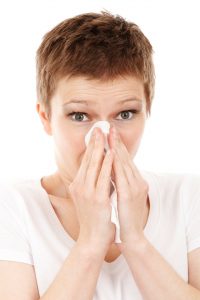Mold can be anywhere and everywhere. So what does that mean for you health?
According to the Centers for Disease Control and Preventions exposure to damp and moldy environments may cause a variety of health issues, especially if one is sensitive to mold(s).

Molds produce allergens (substances that can cause allergic reactions) and irritants. Common symptoms are stuffy nose, throat irritation, coughing, eye irritation and even some skin rashes. Patients that are allergic to mold(s) can have more serious issues, which can lead to chronic illnesses.
The Institute of Medicine in 2004, has found evidence to link indoor exposure to mold with upper respiratory tract symptoms. These may lead to more serious issues such as pneumonitis.
Health care practices
Boosting your immune system through natural supplements and chiropractic care have shown to help patients. At Holistic Healing Chiropractic we take a whole body approach and even use Chinese medicine with chiropractic acupuncture to help with upper respiratory, sinus and general health issues.
I strongly encourage you to have you house checked for mold if you or your family members are chronically battling with upper respiratory symptoms.
Mold can be anywhere and everywhere
Mold can be in your house, office or in your car. You need to make sure that you are checking each place that moisture could penetrate so mold will not grow.
 Mold in the air outside can attach itself to clothing and shoes and be carried indoors. Mold can also enter your home through open doorways, windows, vents, and heating and air conditioning systems. Mold can grow on virtually any substance including carpet, wood and paper.
Mold in the air outside can attach itself to clothing and shoes and be carried indoors. Mold can also enter your home through open doorways, windows, vents, and heating and air conditioning systems. Mold can grow on virtually any substance including carpet, wood and paper.
It is impossible to get rid of all mold. Fundamentally mold control is moisture control. If you have a mold problem attend to it immediately and resolve the water problem.
Mold testing
Molds reproduce by tiny spores that are invisible to the naked eye. Mold testing will show the type and quantity of mold present.
A certified mold inspector will perform a complete inspection. This will cover:
- a non-invasive, visual examination;
- moisture, temperature and humidity measurements;
- and mold samples.
Mold prevention tips
The Environmental Protection Agency advises amongst others:
- Reduce indoor humidity (to 30-60%) to decrease mold growth by:
- Venting bathrooms, dryers and other moisture-generating sources to the outside
- Using air conditioners and de-humidifiers
- Increasing ventilation
- Using exhaust fans whenever cooking, dishwashing and cleaning
- Clean and dry any damp or wet building materials and furnishings within 24-48 hours to prevent mold growth.
- Clean mold off hard surfaces with water and detergent, and dry completely. Absorbent materials that are moldy, such as ceiling tiles, may need to be replaced.
- Prevent condensation: Reduce the potential for condensation on cold surfaces (i.e., exterior walls, roof, or floors) by adding insulation.
- In areas where there is a perpetual moisture problem, do not install carpeting.
In summary, molds are a part of our natural environment and play an important role in our ecological system. Indoors, however, they should be avoided!

Dr. Gary Draper, DC graduated from Palmer College of Chiropractic in Davenport, IA. He’s the owner of Holistic Healing Chiropractic in Cornelius, NC. Dr. Draper carries numerous certifications and strives to continue to learn to help his patients.

Dominic Sielemann is an NC and SC licensed home inspector and indoor air quality consultant. He’s the owner of Kulumo Consulting. Kulumo offers professional home inspections, mold and radon testing for a healthy home and family.
The views, thoughts and opinions expressed by our writers
belong solely to them and do not represent
LKNConnect.com, its publisher or its staff.



